ALSACE VOSGES - Guebwiller - Rimbach - Hirzstein
Year of visit: 2010
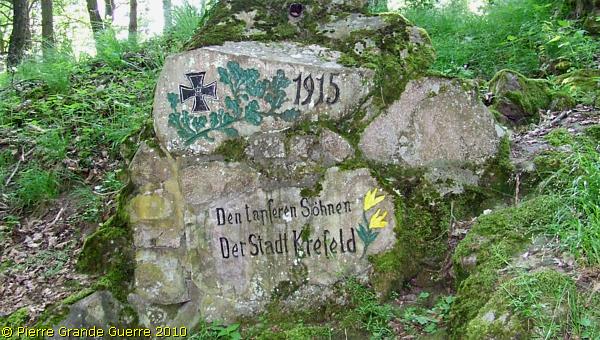
From the Hartmannswillerkopf we continue to Guebwiller, to visit the German "Hinterland" of the Hartmannswillerkopf front sector. First we will visit the Guebwiller Franco-German war cemetery, next we will visit some bunkers of the "Rimbachstellung" at Rimbach, and we will finish with some bunkers at the Hirzstein.
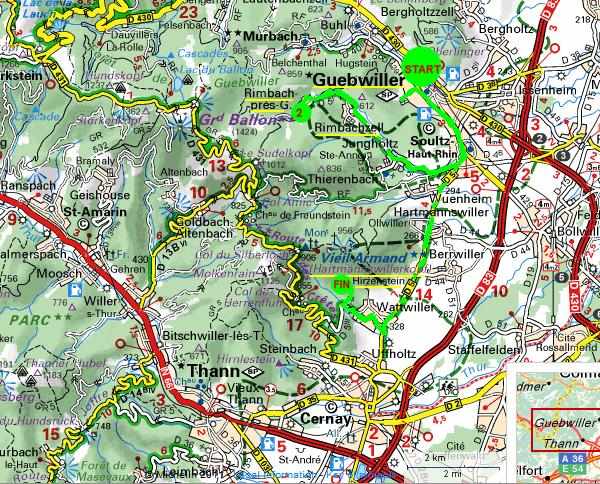
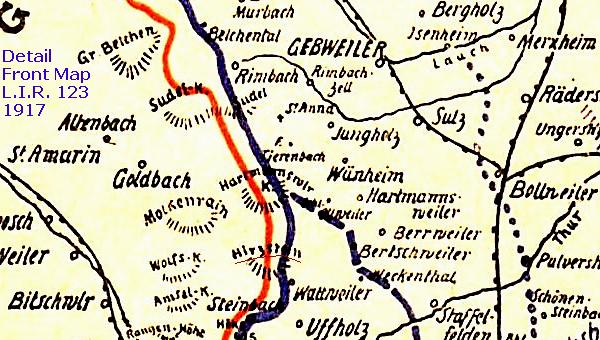
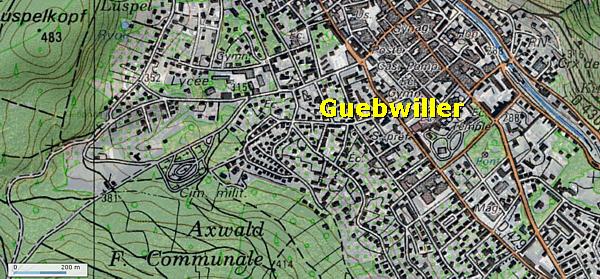
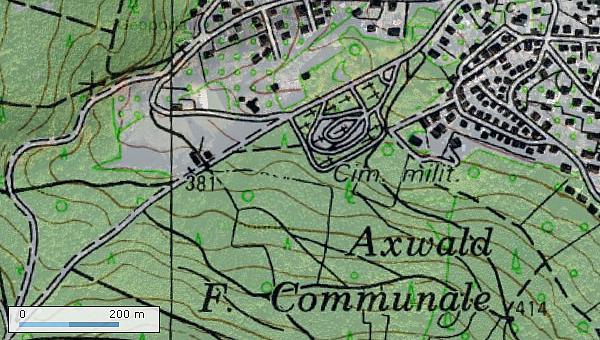
At the western outskirts of the town of Guebwiller we visit the Franco-German war cemetery; the Deutsche Kriegsgräberstätte Guebwiller, and the Nécropole Nationale de Guebwiller.
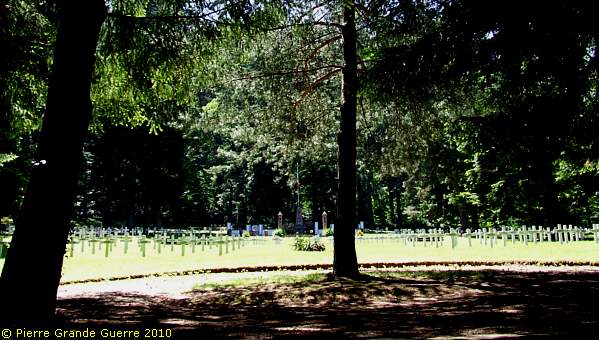
At the entrance of the cemetery we find this memorial:

In the frame below I tell you more about the backgrounds of this memorial.
|
David Bloch |
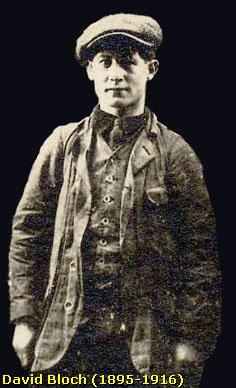
David Bloch was born at 27 November 1895 in a French, Jewish family in Guebwiller. Bloch worked for a number of years in France. At the outbreak of the Great War Bloch and his parents still officially resided in the German “Reichsland Elsaß-Lothringen”.
Though all French men in the “Reichsland” of Alsace-Lorraine were considered as second rate citizens, they were subject to the German military conscription laws. So, David Bloch was also called for the German military service. Bloch, being a French patriot, stubbornly refused to serve, and instead he enlisted in the famous French “Red Devils” Regiment, the 152 R.I., nowadays based in Colmar.
As Bloch’s health condition was not fit enough to fight, he was placed in a war factory. Out of frustration of not being able to fight he contacted some staff officers at Epinal with an audacious plan. Bloch planned an operation, in which Bloch was dropped by an aircraft on a reconnaissance mission behind the German lines near Mulhouse. Bloch’s plan was to collect intelligence in the German lines and to be picked up after ten days by an airplane at a predefined location.
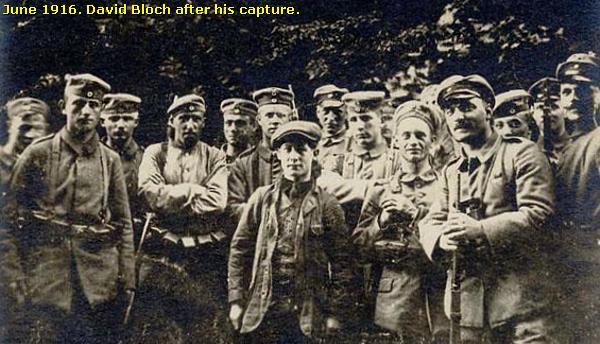
At 23 June 1916, at 2.30 hrs AM, the airplane left from Belfort with David Bloch. After landing near the village of Merxheim the airplane was severely damaged. Following his orders how to handle in case of these accidents the “Sergeant-Aviateur” set fire to the wreck and released his three pigeons. Bloch went his own way, and hid himself in a nearby wood.
When the morning light arrived, and when Bloch left the wood to orientate himself, the Germans immediately captured Bloch, considering him a spy, and charged him with treason. After a trial at a court-martial in Mulhouse Bloch was executed on 1 August 1916 at the village of Ile Napoléon, nowadays at the north-eastern outskirts of Mulhouse. As he was standing in front of the firing squad, Bloch apparently cried his last words: “Ma patrie me vengera!”, “My fatherland will revenge me!”
The first memorial to David Bloch
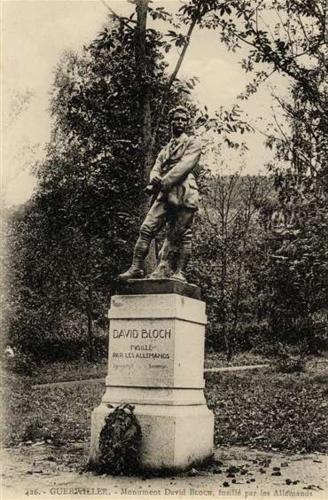
For Alsatian Jews in particular, David Bloch
became a symbol of Jewish, French patriotism. The memorial of nowadays
is the second memorial for David Bloch. The original memorial was
inaugurated in 1922. During the Second World War the Nazi Germans
considered the French patriot, Bloch, still as a traitor, and for being
also a Jew, the Germans destroyed the original memorial for David
Bloch.
Some details of the memorial of David Bloch.
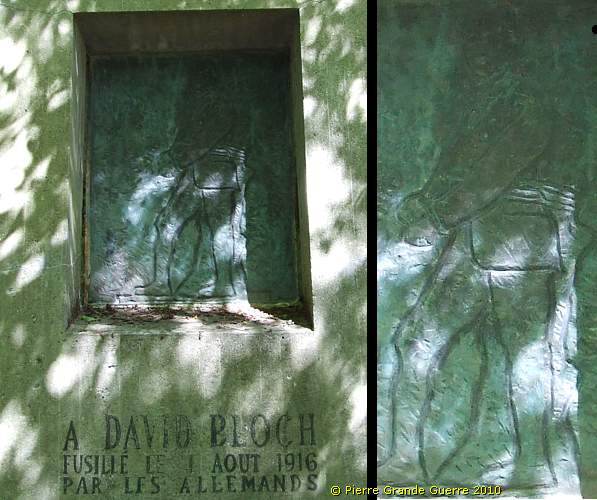
The centre of the circle shaped, military cemetery of Guebwiller is reserved for French soldiers. The outer circle is reserved for the graves of German Soldiers.
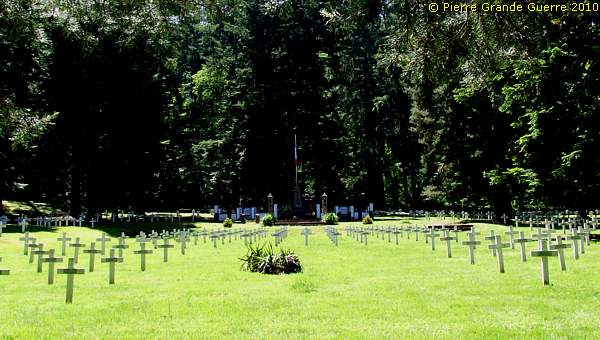
We start at the outer circle of the Deutsche Kriegsgräberstätte Guebwiller .

The Deutsche Kriegsgräberstätte Guebwiller was created in 1914 by German soldiers for burying both French and German soldiers. In the outer circle rest 1.238 German soldiers, victims of both World Wars. The majority, 1.063 burials, is from the Great War. All soldiers, buried here, French or German, have fallen on the nearby front from the Grand Ballon in the west until the Hartmannswillerkopf in the south.
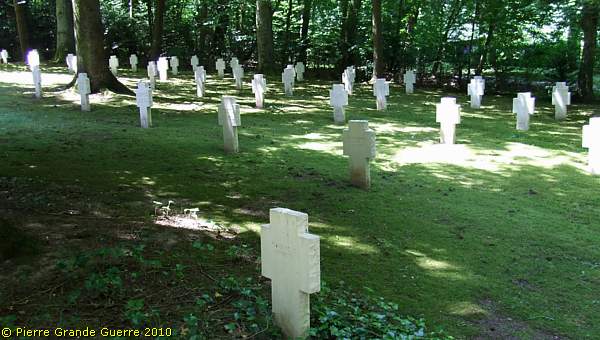
Sometimes one grave contains 3 or 4 soldiers.
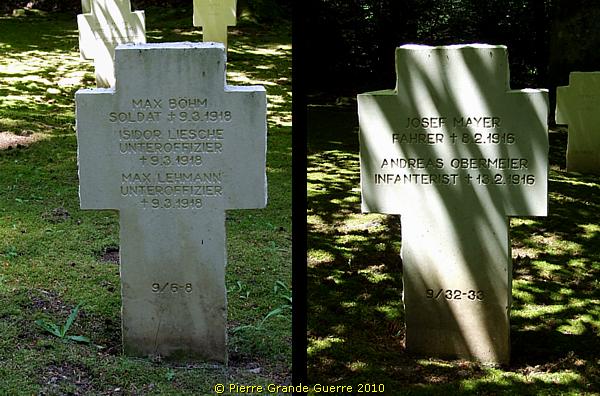
On the western side of the cemetery lies a mass grave.
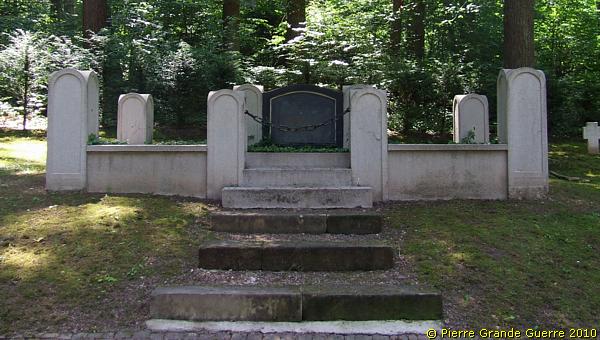
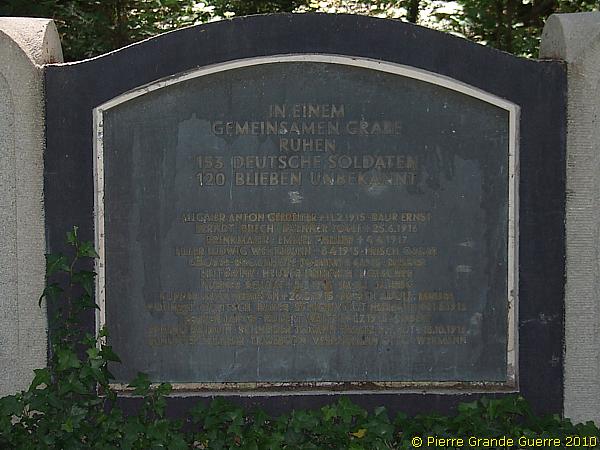
Only some few days before we visited the cemetery, ...
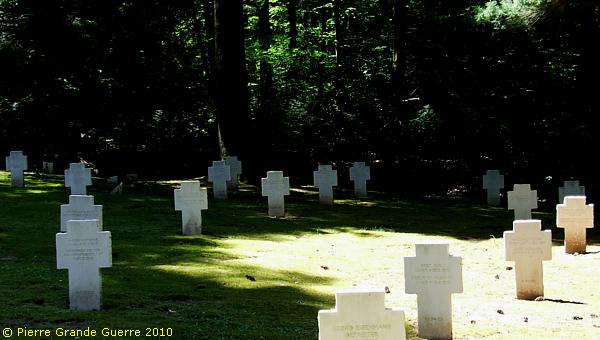
... some ignorant vandals demolished 95 German headstones.
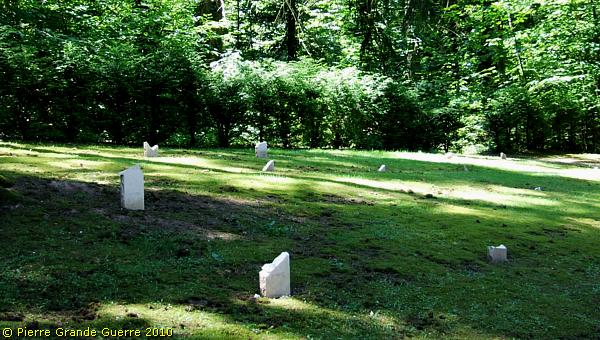
A French press release of 28 May 2010 tells us:

| "28 May 2010. Headstones of German soldiers defiled in Alsace Some hundred graves of German soldiers, fallen during the First and Second World Wars, have been defiled on the cemetery of Guebwiller, in Haut-Rhin, as the Préfecture of Hait-Rhin announced last Friday. In total 95 graves of this Franco-German cemetery have been defiled in the night of Thursday to Friday. The Préfecture added that the crosses of several graves have been broken or have been forced to fall down, but it also stated that it does not possess any other details. An offensive expression has been left on one of the graves. The Prefect of Haut-Rhin and even the Mayor of Guebwiller have personally visited the site themselves. The cemetery of Guebwiller contains the graves of 1.238 German soldiers, and approximately the same number of French soldiers." Unfortunately, this despicable phenomenon is not unique. In the same month several graves of the Loos British Cemetery were defaced and severely damaged. |
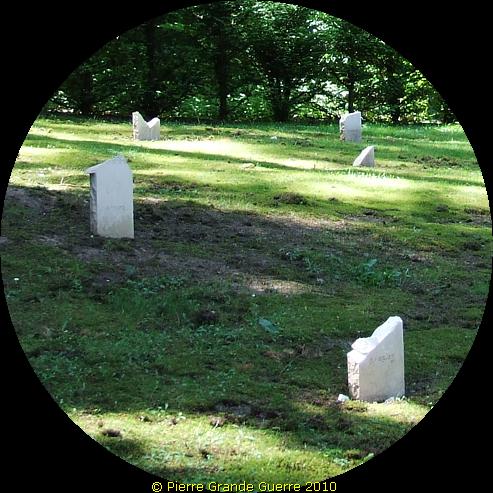
Annoyed by this stupid vandalism we continue our walk over the cemetery.

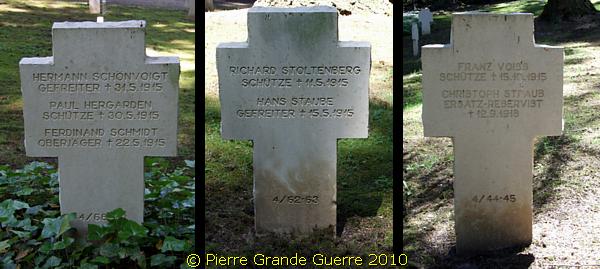
From the outer circle we step over to the inner circle, to ...
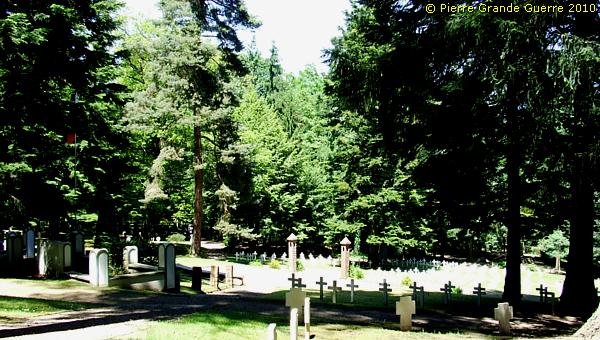
... the French Nécropole Nationale de Guebwiller .
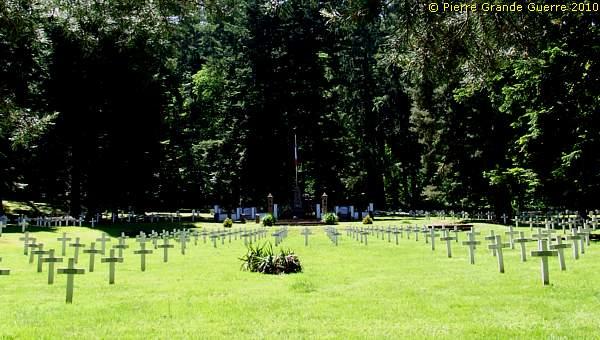
The Nécropole Nationale de Guebwiller contains the graves of 457 soldiers. Soldiers are buried in two communal graves. Among these graves there are also 9 graves of Russian soldiers.
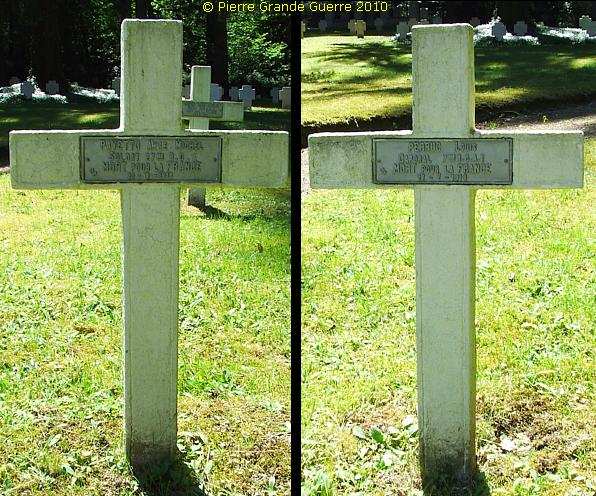
Grave of a Chasseur Alpin of the 7e B.C.A.T(errittoriale).

Before the main memorial and the flag stand two columns...
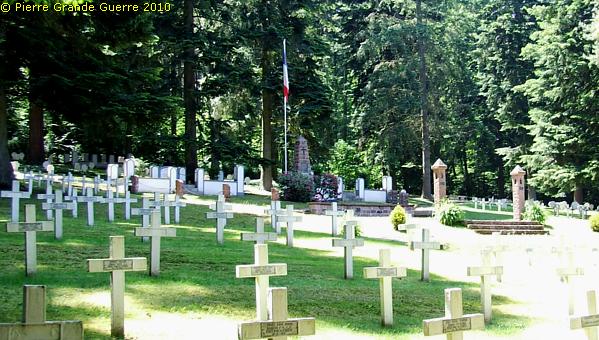
... guarding the monument with each a Latin inscription.
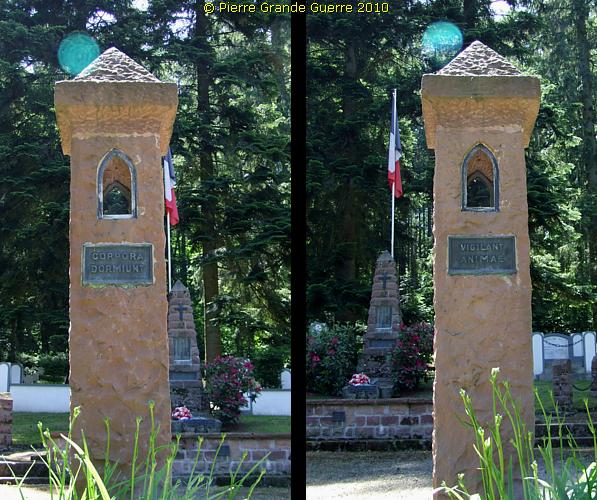
The memorial is flanked by two communal graves.
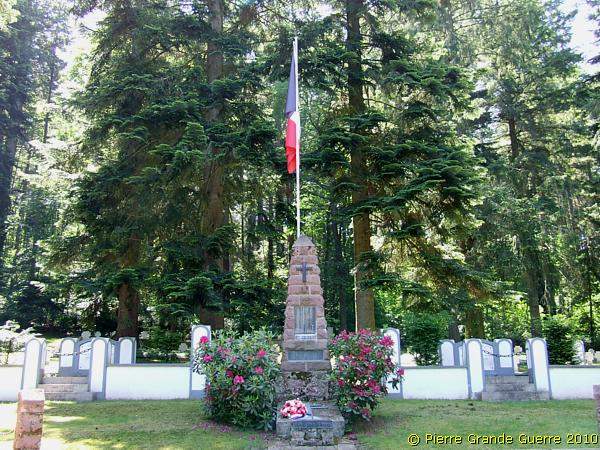
On the left, Ossuary no. 1.
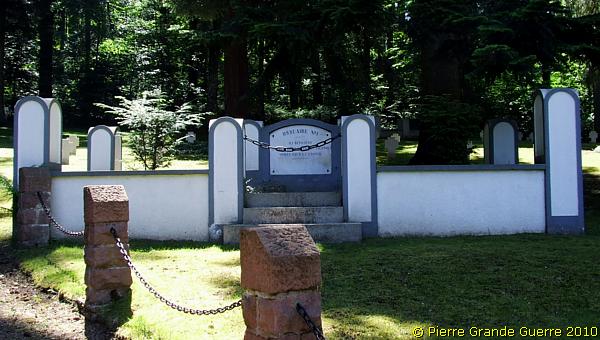
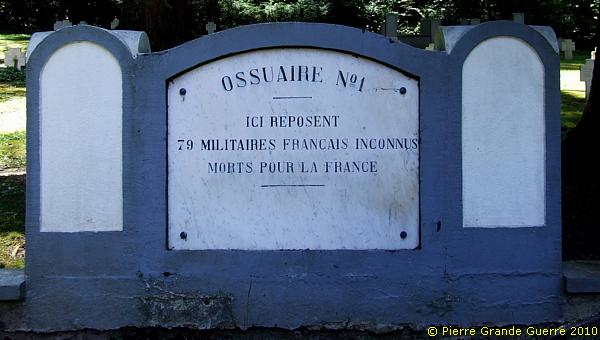
On the right side of the memorial is Ossuary no. 2.
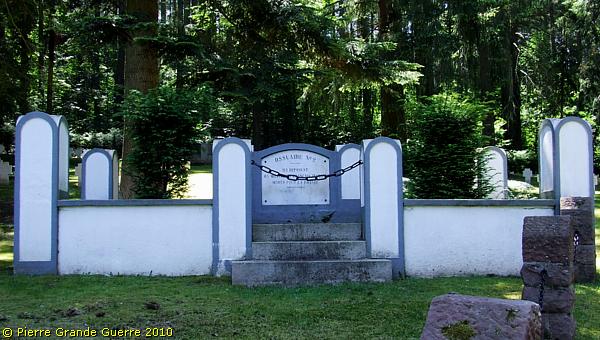
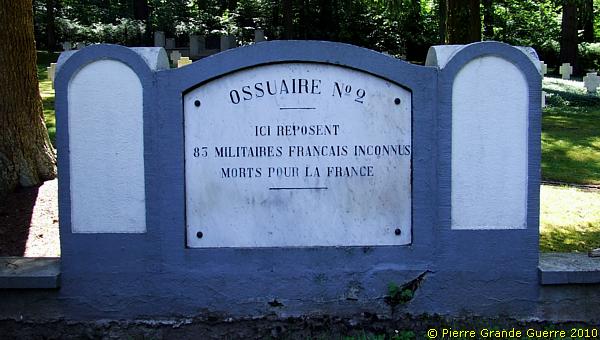
Let us have a closer look at the memorial in the middle.
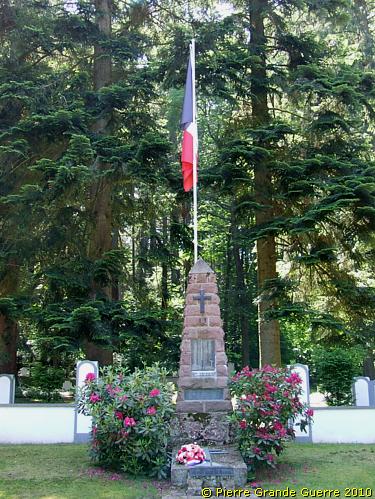
On the memorial there are three interesting bronze reliefs.
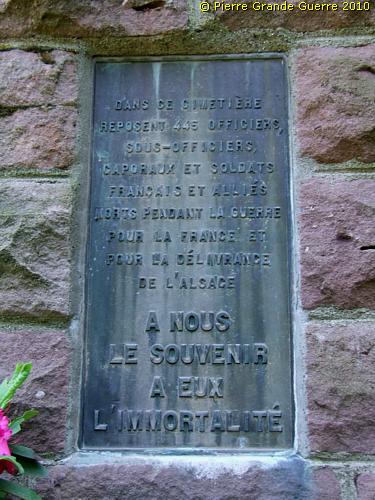

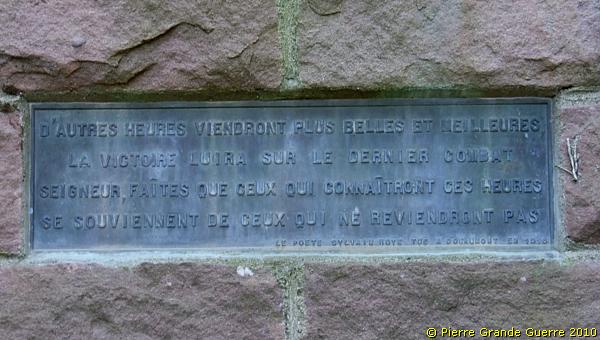
The third bronze relief attracted me the most.
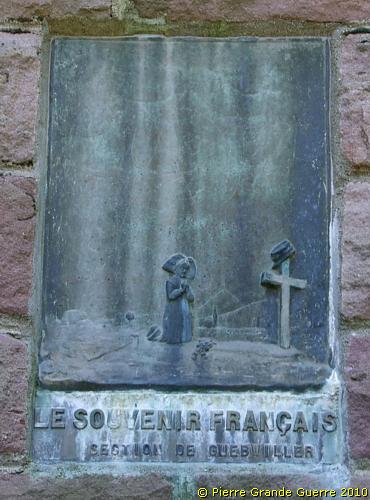
Being an aficionado of the French patriot and Alsatian illustrator, Hansi, I immediately recognised the scene in the bronze relief from the original work of Hansi. Watch and compare below the two images of Hansi's work.
Visit also my Special Photo Impression about " Colmar and Hansi, the Illustrator "!
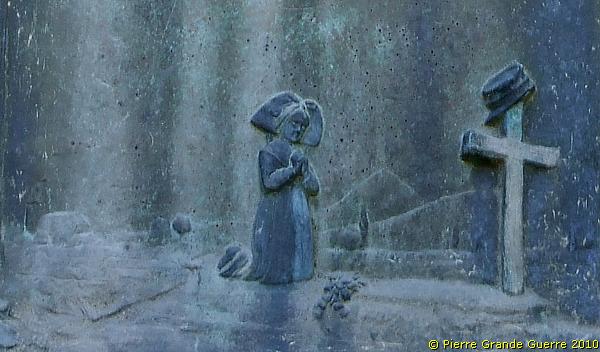

The memorial is also dedicated to all French victims of all wars and conflicts of the 20th century, ...
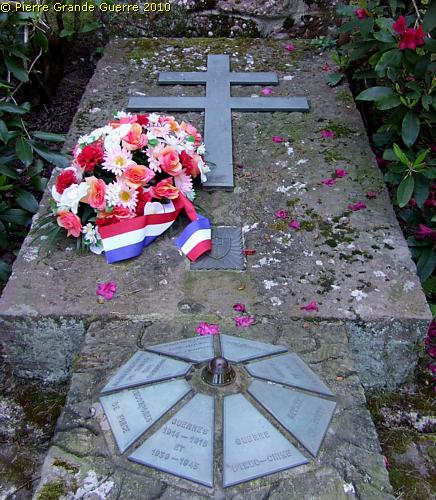
... including the victims of the war in Indo China, the Resistance, and of the concentration camps of the Second World War.
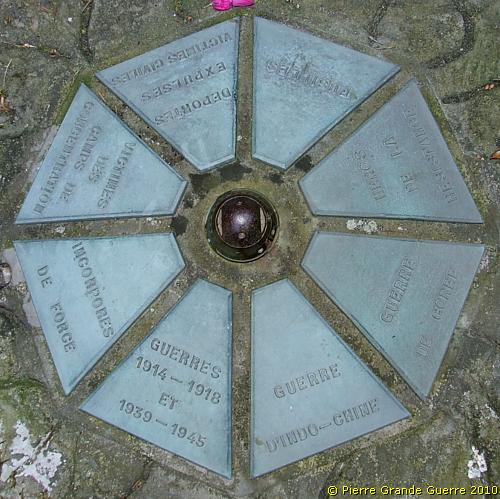
A last view at the Guebwiller War Cemetery.

We continue by car south- and westward to Rimbach.
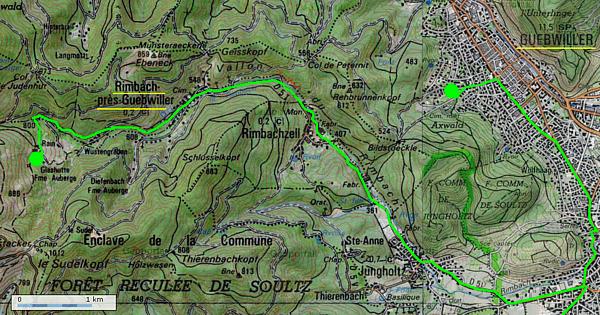

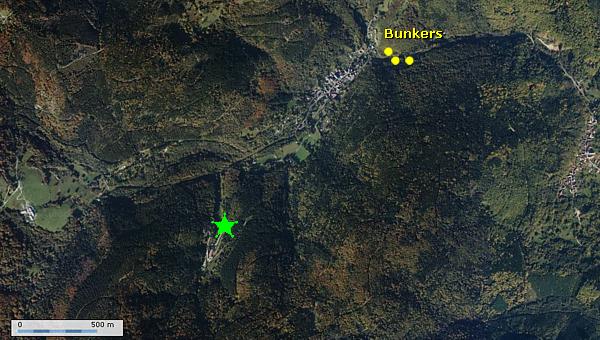
We first park our car at the eastern outskirts of the hamlet of Rimbach-près-Guebwiller .
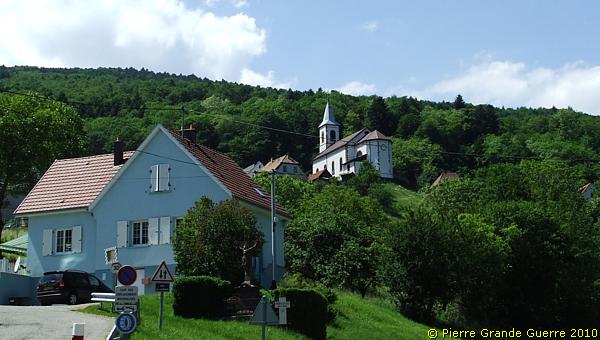
The main reason for me to visit Rimbach forms the presence of the “Württembergische Gebirgsschützen” in 1915 and 1916.
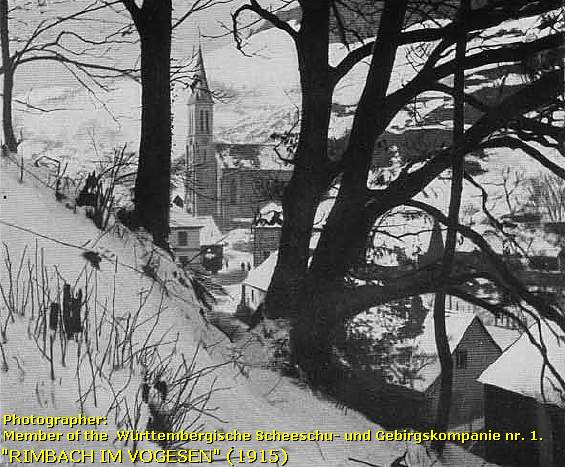
"Furchtlos Und Treu": The Württembergische Gebirgsschützen
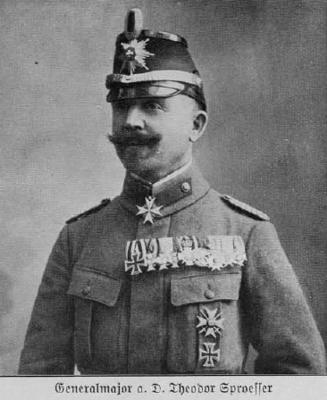
After the training period in Baiernfurt near Weingarten, Germany, the “Württembergische Scheeschu- und Gebirgskompanie no. 1”, under command of Major Theodor Sproesser, arrived on 28 January 1915 at the front near Rimbach for their first fighting experiences.
The origins of the Württembergische Gebirgsschützen

At the start of the war the German Landwehrmänner, stationed in the Vosges, had no adequate defense against the fast mountain warfare tactics of the skiing elite troops of the Chasseurs Alpins.
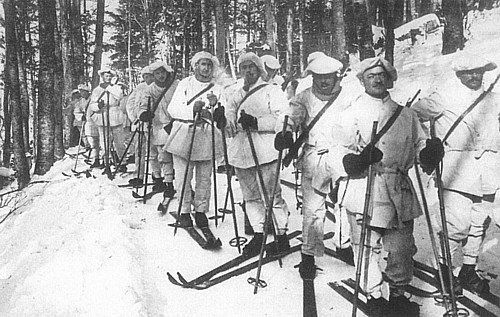
Following the example of the Bayerische Skiverband (Bavarian Ski Sport League) , the Swabische SchneeschuBund made an offer on 21 October 1914 to the Württembergische Kriegsministerium (War Office) to create a special forces ski unit, a "freiwilligen Skikorps", composed of volunteers, members of the Swabische Ski Sport League.
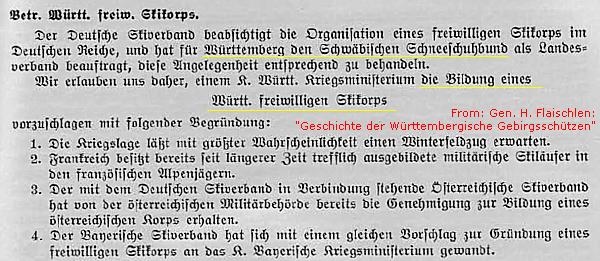
At first Berlin refused this offer of the Swabische SchneeschuBund. But in November 1914 General von Gaede requested the Oberste Heeres Leitung for new ski-units with a military training, which was better fit for winter mountain warfare, and which was better able to withstand the tactics of the Chasseurs Alpins.
The “Württembergische Scheeschu- und Gebirgskompanie no. 1”
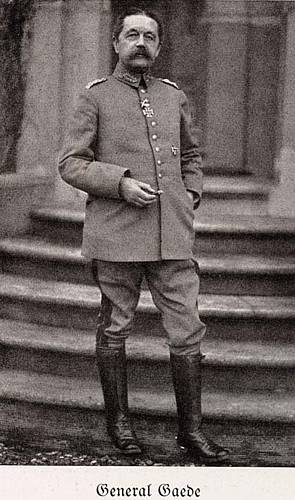
After the request of General von Gaede the Württembergische Kriegsministerium got permission on 28 November 1914 to create the “Württembergische Scheeschu- und Gebirgskompanie no. 1” out of volunteers of the Swabische SchneeschuBund.

First assignment: Rimbach
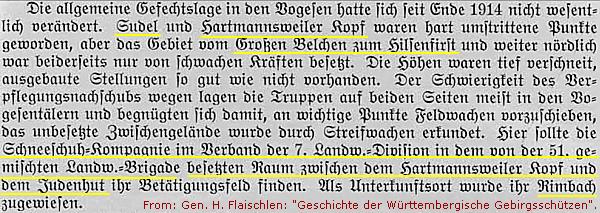
At Rimbach the “Württembergische Scheeschu- und Gebirgskompanie no. 1” was assigned to man the advanced posts on the Hartmannswillerkopf , the Sudel , and the Judenhut, and to patrol the No Man’s land to attack French patrols and advanced posts.
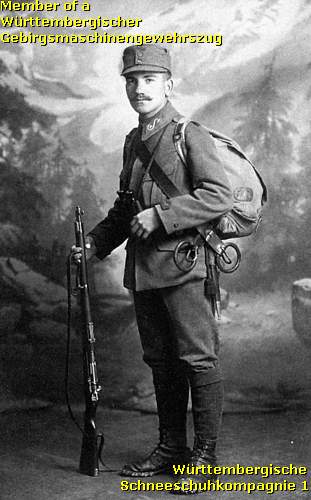
The Württembergische Gebirgsschützen formed a fighting unit of the 51. Gemischten Landwehr Brigade of the 7. Landwehr Division.

“Württembergische Gebirgs-Kompagnie Nr. 1”
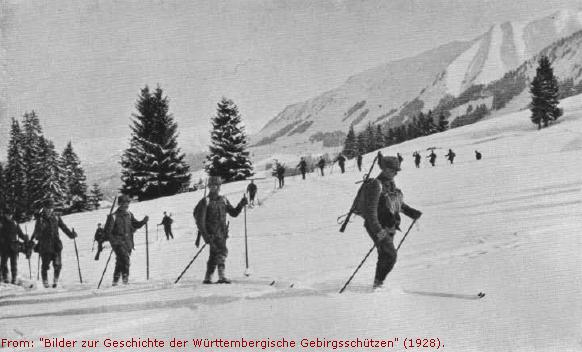
Being such a success the unit was soon extended in February from 2 platoons to 4 platoons. On 13 April 1915 the unit was renamed in “Württembergische Gebirgs-Kompagnie Nr. 1”.

The “Württembergisches Gebirgs-Bataillon”
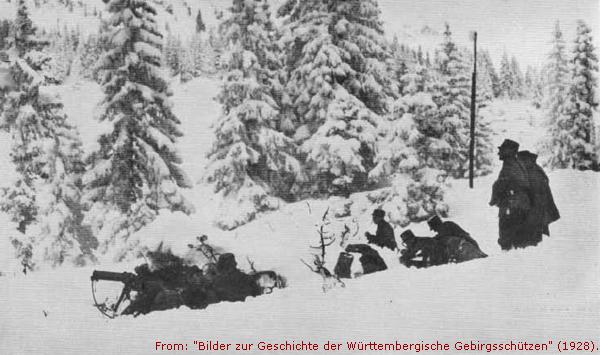
On 1 October 1915 the unit was renamed in “Württembergisches Gebirgs-Bataillon”. During a training at Münsingen, Germany, the unit was extended to 6 companies, and it existed of 6 mountain machine-gun platoons, a total of 39 officers, 1.620 “Unteroffizieren und Mannschaften“, and 258 horses. After a short stay in Tirol the “Württembergisches Gebirgs-Bataillon” returned on 31 December 1915 for duty in the “Oberelzaẞ” as a component of the 55. Landwehr Infanterie Brigade of the 7. Landwehr Division.
The “Weinachtskämpfen” of the Hartmannswillerkopf
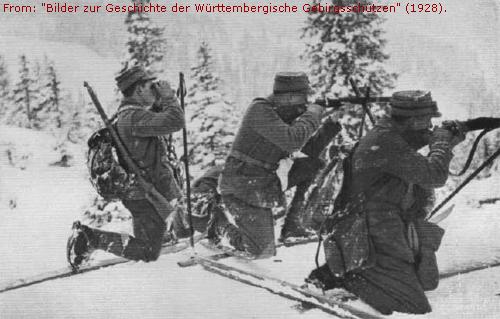
After it's arrival the unit was immediately deployed in the “Weinachtskämpfen”, the Christmas Battles (21 December 1915 – 9 January 1916) of the Hartmannswillerkopf. During these fights for the Sudel, the Hartmannswillerkopf, and the Hirzstein, a group of 39 volunteers under command of Leutnant Ortlieb formed one of the first "Sturmtruppe"-units and experimented successfully with light equipped storm trooper assault tactics. When the Christmas Battles were over, the unit defended the lines at the Hilsenfirst, the Ilienkopf and the Pétit Ballon until 20 October 1916.
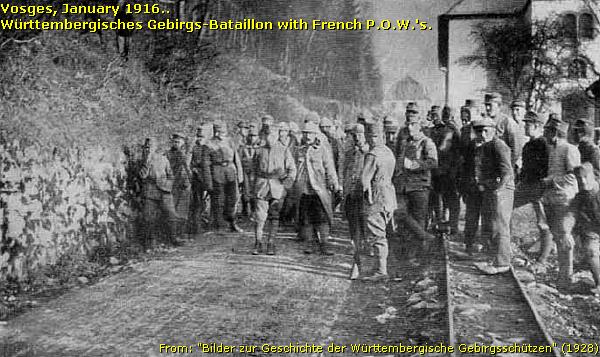
Romania, Macedonia, and the Isonzo
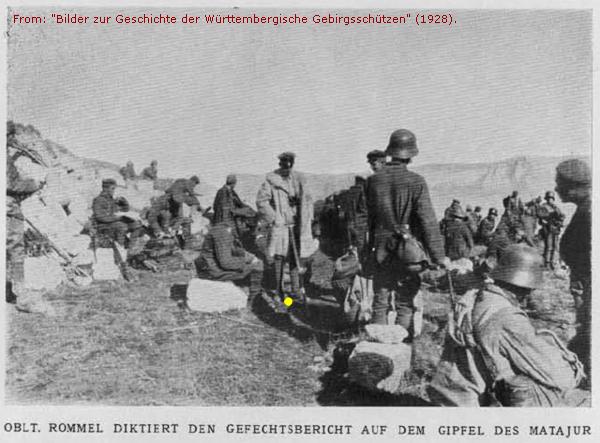
The unit was transferred first to the front of Romania until February 1917. Next the unit fought in Macedonia. From 10 October 1917 the unit played, as a component of the 14 Armée and the “Alpenkorps”, an important role during the Isonzo Battles at the Italian Front.
Oberleutnant Rommel

The most famous officer of the “Württembergische Gebirgsschützen” was the commander of the storm trooper unit, “Abteilung Rommel”, Oberleutnant and Kompanieführer, Erwin Rommel , who would leave the war in 1918 as Hauptmann, Captain. Rommel would later make a splendid career to the rank of “Generalfeldmarschall”, General Field Marshall, until his by the Nazi’s forced suicide on 14 October 1944.
The Hirzstein
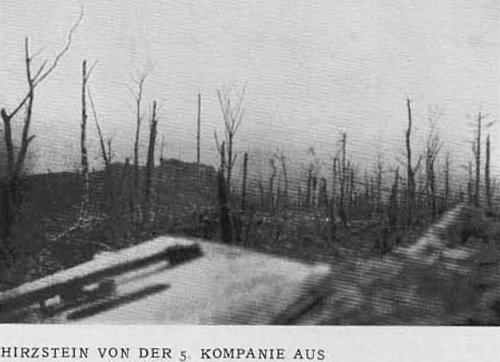
In February 1918 the “Württembergisches Gebirgs-Bataillon” returned again to the Vosges front, to the base at the Hirzstein, to defend the lines of the Hartmannswillerkopf front sector. Some companies were detached to assist in the defence of the Hilsenfirst, the Reichackerkopf , and the Barrenkopf until 3 May 1918.
The “Württembergisches Gebirgs-Regiment”
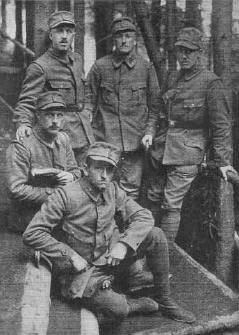
From then on the unit was reorganised again,
renamed in the “Württembergisches Gebirgs-Regiment”, and transferred to
the
Chemin des Dames
to
take part in the Spring Offensives of the Kaiser’s Battle and later at
the battlefields of the
Marne
, the
Champagne
, again the
Alsace, and at last Verdun. The unit was dissolved after the Armistice
on 21 December 1918, serving as a border guard unit, at Waldhut, near
the Swiss border.
Source:
General H. Flaischlen: "Geschichte der Württembergische Gebirgsschützen" (1922)

With all this in mind we return now to nowadays Rimbach. Just before entering the village we detect some concrete
in the dense vegetation on the south side of the road.
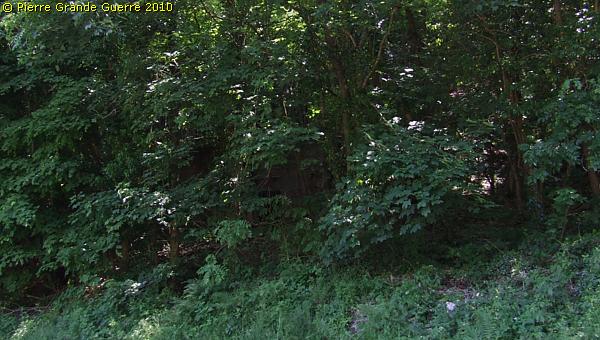
On private premises, which I cannot enter, I detect two bunkers next to each other.
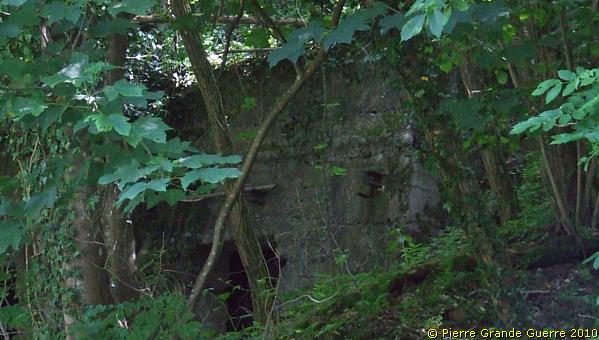
Of course these bunkers have been constructed by Pioniere and Landwehrmänner, and not by the elite fighting troops of the Württembergische Gebirgsschützen.
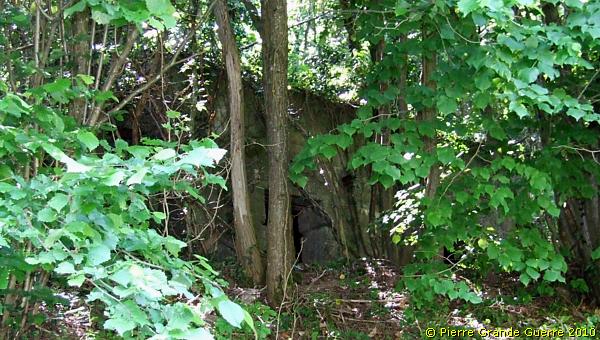
At the northern side of the road, where we parked our car, a pony-breeder converted a bunker into a stable for his ponies.
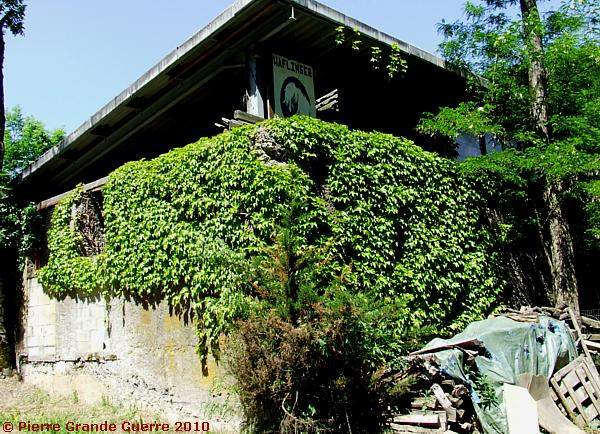
The eastern side of the bunker without a roof. It is a rather large bunker with an estimated length of 15 m.
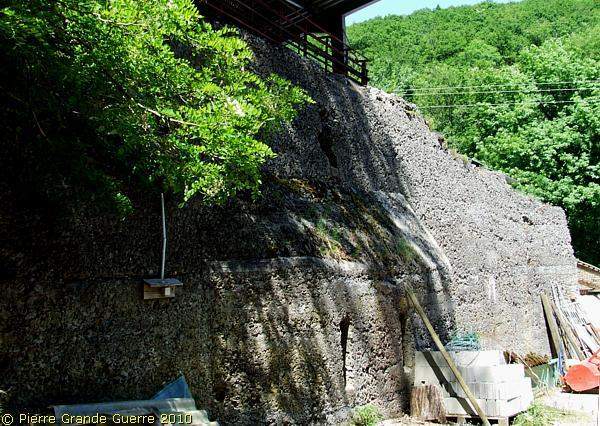
The roadside, the southern side of the bunker.
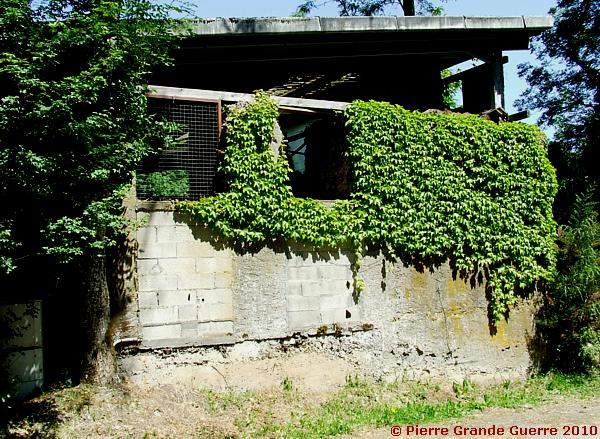
The last doubt of being it a stable or a former bunker vanishes, when I take a closer look at the thickness of the concrete walls. Ponies don't need such thick concrete walls!
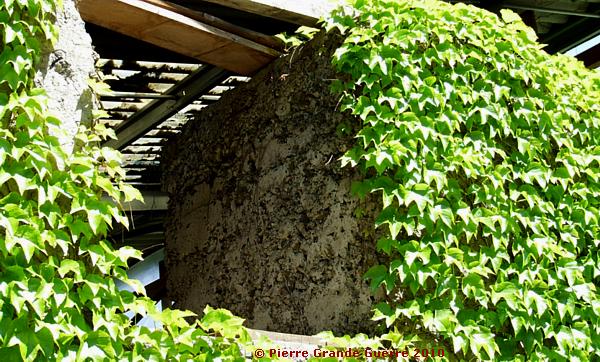
The south-west side.
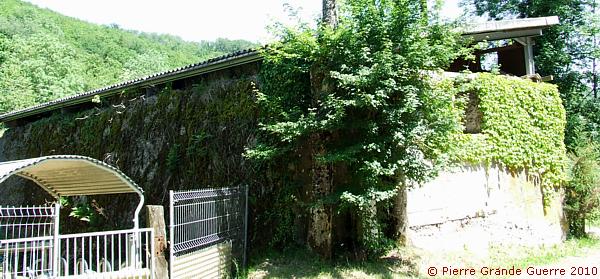
From Rimbach we continue by car westward, ...

... following the dead end road upward to a location called Rain.

At a height of 800 m. we have some landscape views of the former "Rimbachstellung". A view eastward.
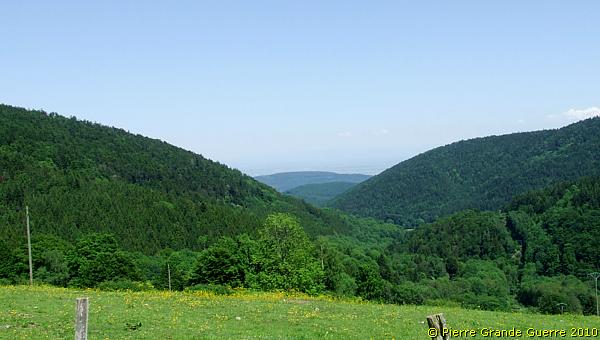
A view southward.
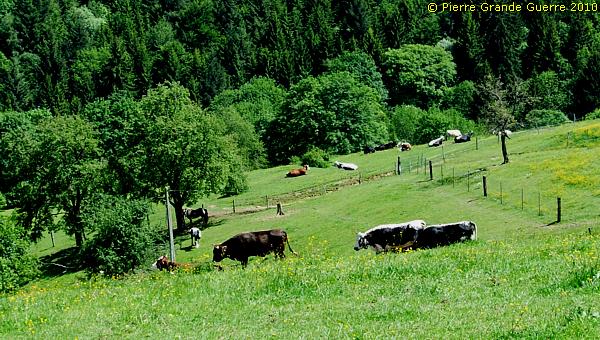
View south-westward to the Sudel or Sudelkopf.
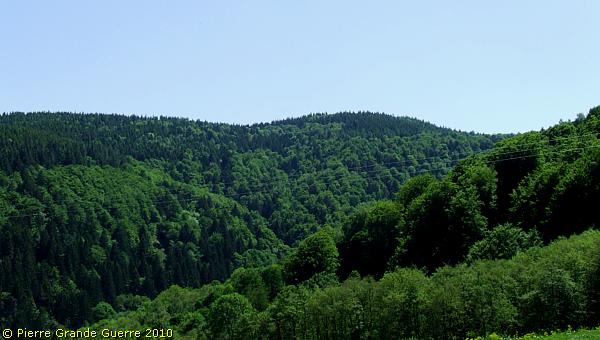
View closeby westward.
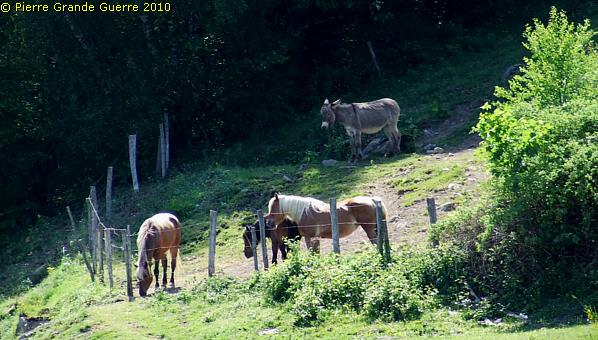
View northward: left the Judenhut, right the Munsteräckerle.
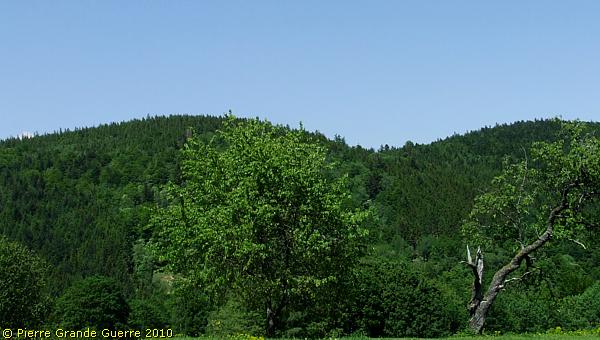
We return along the same road back to Jungholt, ....

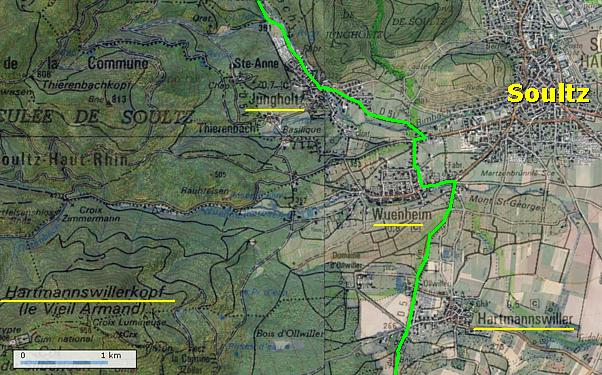
... and we continue southward, passing Wuenheim, following the D 5 to the village of Hartmannswiller.
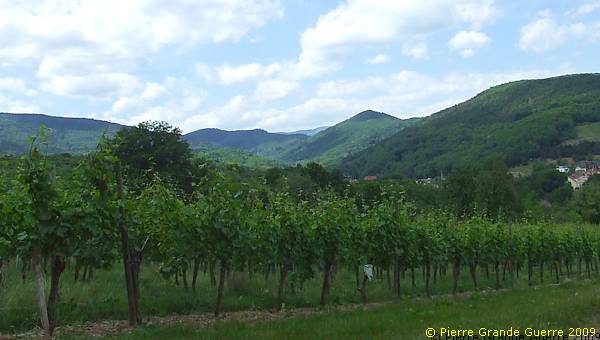
At our right we see the Vieil Armand or the Hartmannswillerkopf.
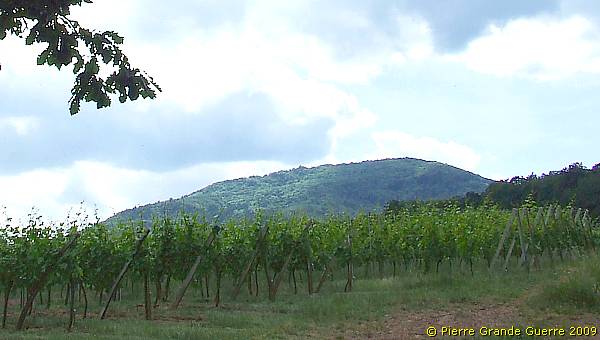
We continue to the western outskirts of Wattwiller.

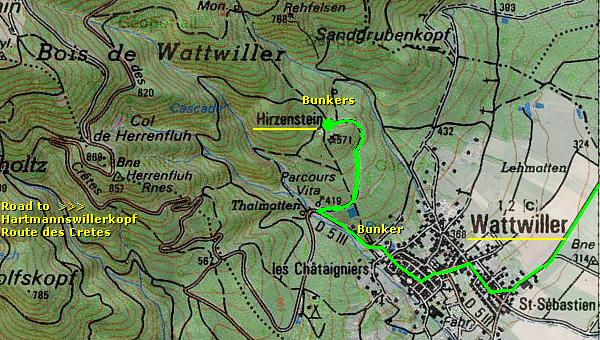
Just when we have left the village of Wattwiller, we find this bunker in the verge of the northern side of the road.
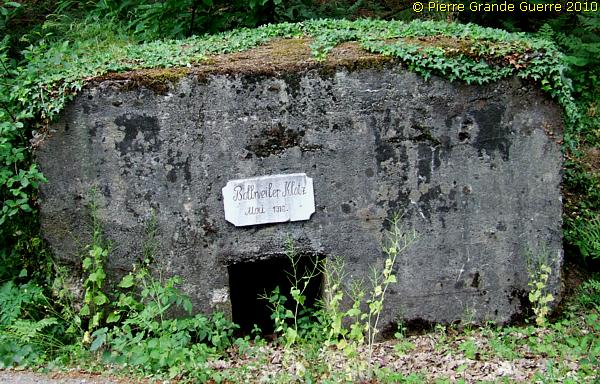
Soldiers humor. Bolwiller is an Alsatian village. The German word “Klotz” knows an extra connotation. It does not only mean block, but it also means klutz or clumsy oaf.
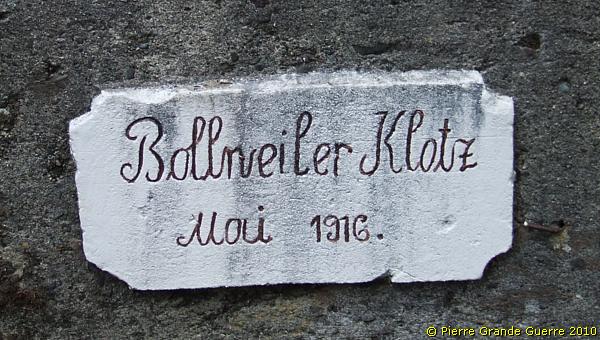
Next we continue upward to explore the Hirzstein for some relics.
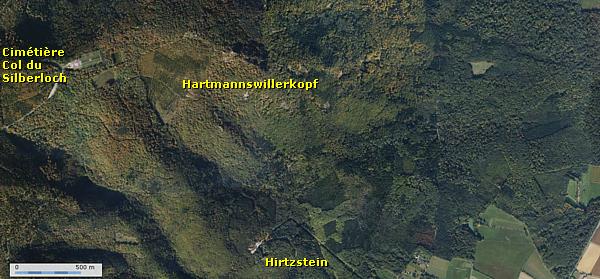

The densely vegetated Hirzstein (570 m.) itself is a quartz rock formation. Hirzstein is also spelled as "Hir t zstein" or Hirz en stein".
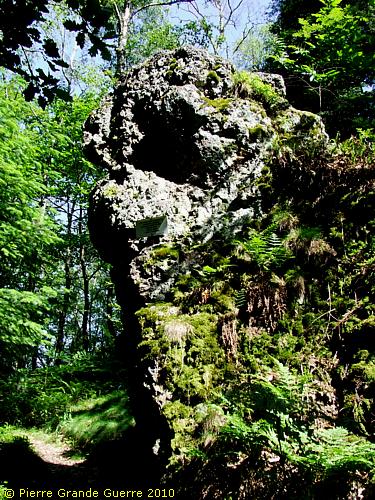
We make a walk over the northern side of the Hirzstein.
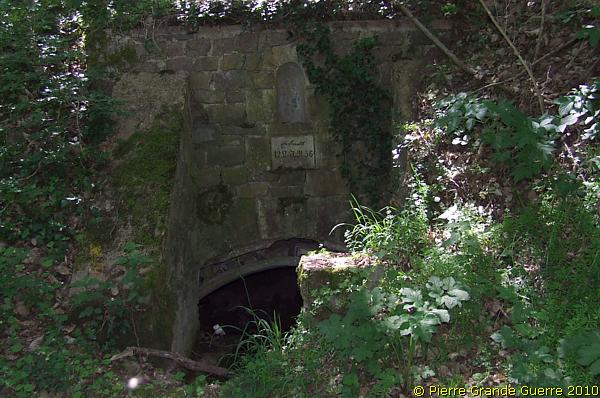
25 December 1914 - The 28e B.C.A. arrives at the Hirzstein
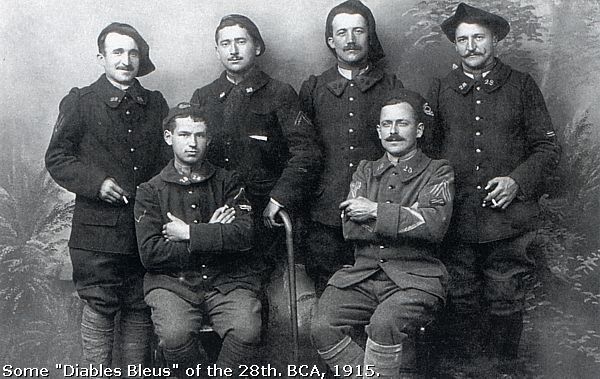
Before 25 December 1914 the area of the Col du Silberloch and the Hirzstein was only visited by some reconnaissance patrols of both belligerent parties. For instance at the start of October a Radfahrer Abteilung of the Württembergische Landwehr Infanterie Regiment 123 scouted the Silberloch and the Hirzstein rock without finding any traces of a French presence. On 28 November and on 4 December there were some skirmishes at the outskirts of Wattwiller of French soldiers with respectively some Württemberger Dragoons and cyclists of the L.I.R. 119.
During the attack of 25 December 1914 at Cernay, south of the Hartmannswillerkopf, the 28e Bataillon Chasseurs Alpins, being a component of the 81e Brigade d’Infanterie of the 66e Division d’Infanterie, formed the right flank of the 81e B.I.
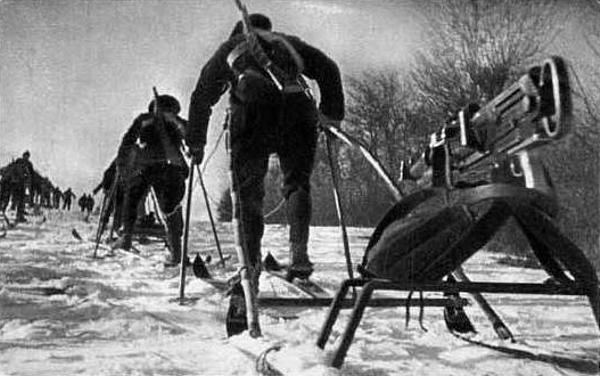
Without being noticed by the Germans the Chasseurs occupied at around 10.00 am the line from the Col du Silberloch until the Hirzstein. Deep into German territory two companies of the 28e B.C.A., under command of Capitaine Regnault, established immediately an advanced position on the Hirzstein by cutting trees to create a field of fire and digging trenches. On the same time the 28e B.C.A. kept contact with their left flank, the 115e R.I., which was located at Rimbach.
26 December 1914. First contacts with the Germans

But the next day, on the 26th, sentinel Mathivaud of the 28e B.C.A., made the first contact with the Germans. After firing two shots Mathivaud captured 2 Feldwebels of the I.R. 25, who lost contact with their company. On the same day the Württembergische Landwehr.I.R. 123 installed itself on the Hartmannswillerkopf.
The Hirzstein, 28 December 1914 – 19 January 1915
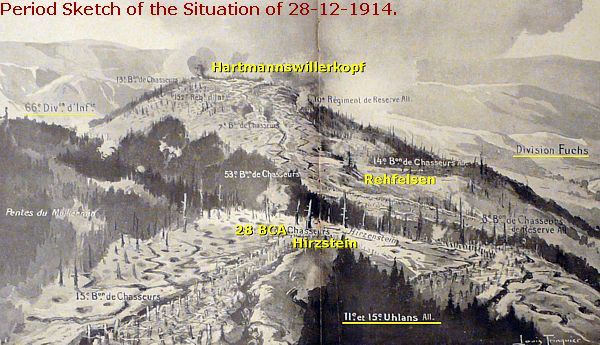
In answer to
the attack at Cernay the Germans immediately organised a counter
attack. With units of the Uhlanen Regiment 11 and U.R. 15, the I.R. 25
and L.I.R. 123, the Germans started the counterattack on 28 December.
On 30 December
1914 there were still heavy fights on the summit for the rock of the
Aussichtsfelsen on the Hartmannswillerkopf, which also involved the
Sudelkopf and the Hirzstein. For both parties the possession of the
summit of the Hartmannswillerkopf was of extreme importance. The party,
who could get control over the mountain and it’s sub-summits,
controlled also the road from the “Crêtes", the summits of the
Vosges, to the Rhine Valley and the valley itself.
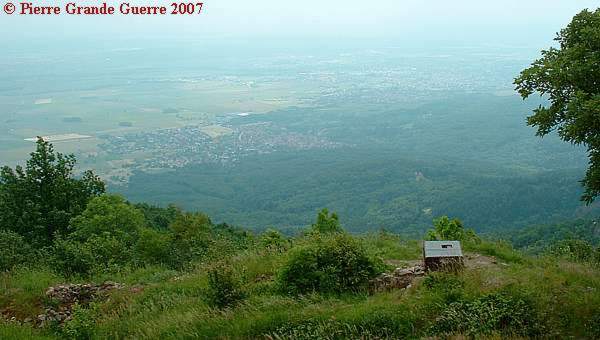
Only until 19 January 1915 the 28e B.C.A. was able to hold the lines at the Hirzstein. On that day the Germans launched an attack with a new special unit, “Pioniertrupp Türk”, or “Minenwerfer Abteilung No.6”. This unit of 46 Pioniere soldiers, under command of Leutnant Killian and Leutnant Türk, possessed 4 heavy 17 cm. mortars. With aid of these Minenwerfer the 51. Landwehr Brigade knew to chase the 28e B.C.A. from the Hirzstein. The fights for the possession of the Hartmannswillerkopf would continue until 1 April 1915, when the Germans secured their position at the Aussichtsfelsen on the Hartmannswillerkopf.
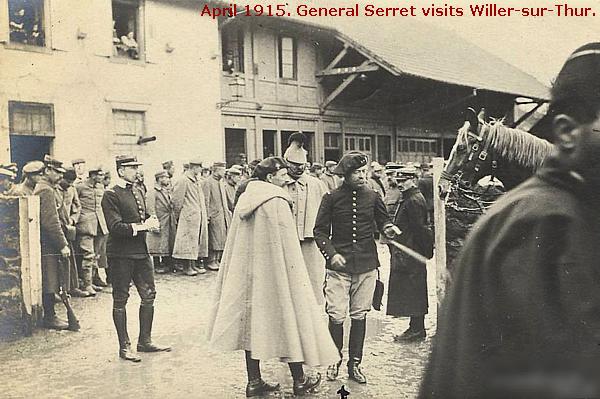
From January until April 1915 the French 66e D.I. of General Serret, with his two Infantry Brigades (81e and 115e), including the famous Red Devils of the 152e R.I., and 9 batallions of Chasseurs Alpins, tried to conquer the summit of the Hartmannswillerkopf and it's sub-summits several times. They captured the western slope of the mountain and a stroke of land at the summit on 29 March 1915.
The Christmas Battles - 21 december 1915- 9 January 1915
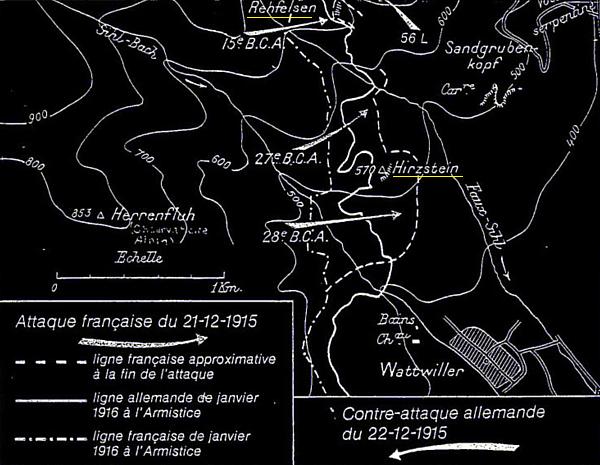
We make jump forward in time of 9 months to the “Weinachtskämpfen”, the Christmas Battles of late December 1915. The “Weinachtskämpfen” for the Hartmannswillerkopf, the Sudelkopf and the Hirzstein, formed the last great battle of the Vosges front until 1918.
17 December 1915
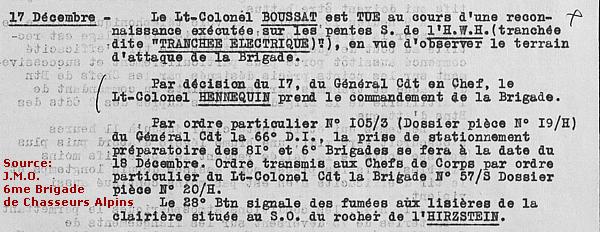
During the preparations for the offensive of 21 December 1915, the Christmas Battles for the possession of the summit of the Hartmannswillerkopf, the 6e Brigade de Chasseurs Alpins lost their commander, Lt. Col. Boussat , on 17 december 1915. While he was on a reconnaissance mission, Lt. Col. Boussat was hit "on the southern slopes of the Hartmannswillerkopf (trench called "Electric Trench"), observing the terrain of the attack of the Brigade". (...) "The 28e. Btn. signals smoke at the edges of the clearance, located south-east of the Hirzstein Rock."
21-23 December 1915
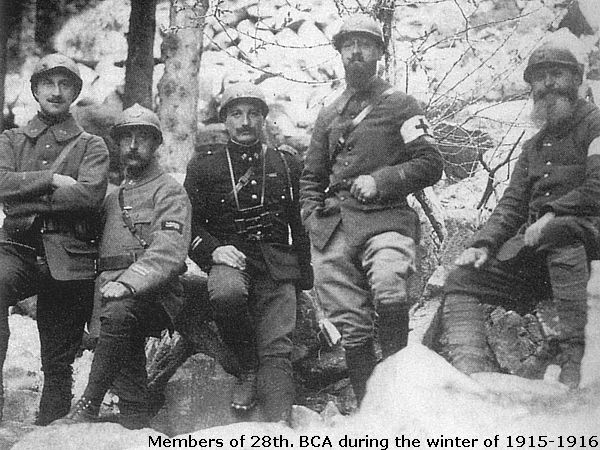
On 21 December 1915 the 66e D.I. launched an attack at the Hartmannswillerkopf with the 81e B.I. under command of Col. Goybet. Supported by artillery it was the task of the 6e Brigade de Chasseurs Alpins, composed by the 7e, 27e and 28e B.C.A. under command of the recently appointed Lt. Col. Hennequin, to conquer the Hirzstein.
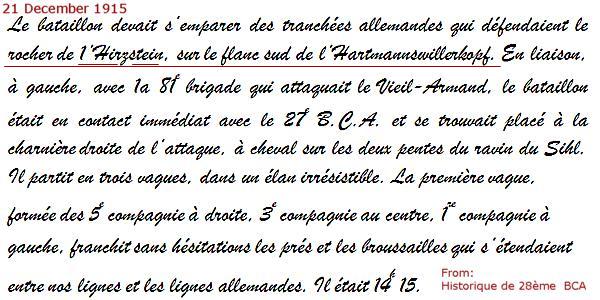
At 15.00 hrs the 28e B.C.A. conquered the Hirzstein, capturing 150 Prisoners of War of the R.I.R. 78.
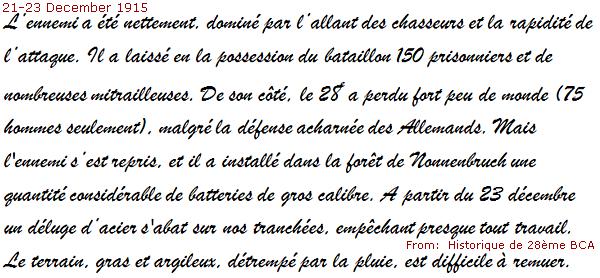
The few units of R.I.R. 78, which survived the attack, would stay in their positions at the foot of the Hirzstein and the village of Wattwiller. In the evening battalions and units of L.I.R. 40, 56, and 126 arrived at Wattwiller together with units of the Württembergisches Gebirgs-Bataillon and of Jägerbataillon 8 to reinforce the rests of R.I.R. 78.
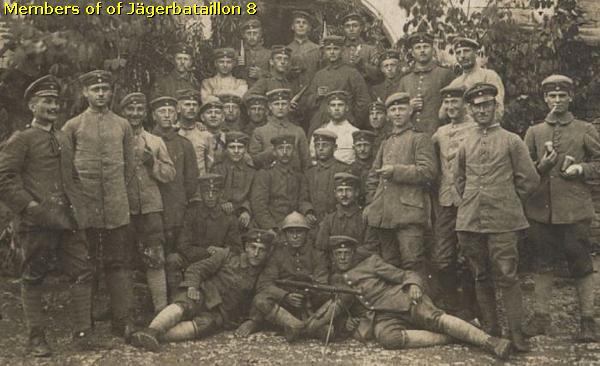
After their conquest of the Hirzstein the Chasseurs immediately started to install themselves in the large tunnel network, which German Pioniere digged in and under the quartz rock during the last 10 months.
28 December 1915 - Change of fighting units

On 28 December the 28e B.C.A. was relieved at the Hirzstein by the 7e B.C.A. The 7e B.C.A. was flanked and reinforced by it’s reserve battalion, the 47e B.C.A., and the 67e B.C.A.

The 28e B.C.A. was kept in reserve, close by behind the lines.
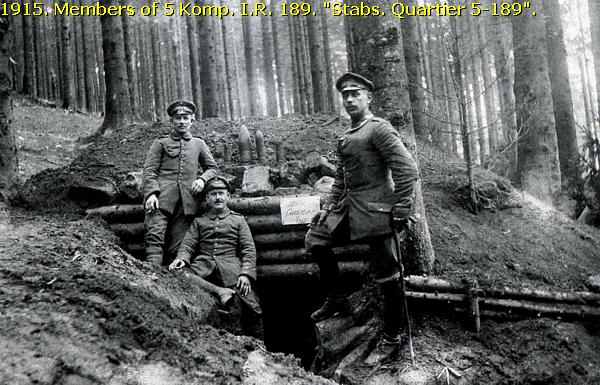
On the same day the 187 Landwehr Brigade, consisting of the I.R. 187, 188, and 189, under command of Oberst von Gundell arrived at the front as a component of the 12. Landwehr Brigade of Armee Abteilung Gaede. It was reinforced with 7 “Minenwerfer Abteilungen”, amongst others the Minenwerfer Kompanie 132, MWK 132, under command of Leutnant Killian with 23 Minenwerfer of various calibres.
New special forces units

Again after a request of General Gaede to the Oberste Heeres Leitung the Armee Abteilung Gaede deployed in the summer of 1915 two new special forces units.
One of these was the unit of Major Reddemann, “Stoẞtruppe Reddemann”, or "Flammenwerfer-Abteilung Reddemann", a light equipped unit, specialised in shock attacks with flame throwers.
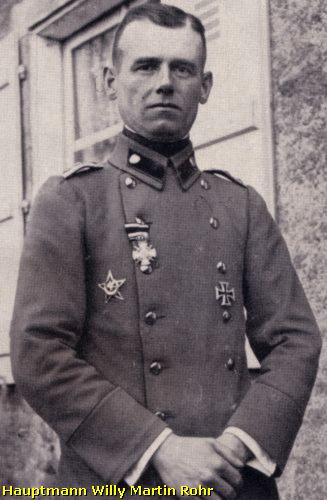
The other unit was “Sturmabteilung 5” under
command of Hauptmann Rohr, a unit of light equipped assault Pioniere, trained
for fast and deep attacks. During the autumn of 1915 both new special
units demonstrated their high value during fights at the
Schratzmännele
, as they
did on 22 December and the following days at the Hartmannswillerkopf.
8 January 1916 - The I.R. 189 recaptures the
Hirzstein
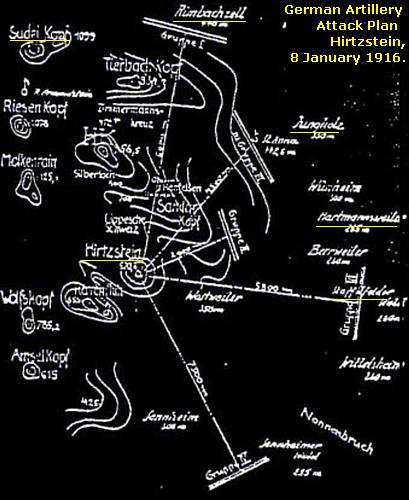
On 8 January 1916 Killian’s Minenwerfer of MWK 132 opened from 5 sides a preliminary bombardment of 10 hours at the Hirzstein.
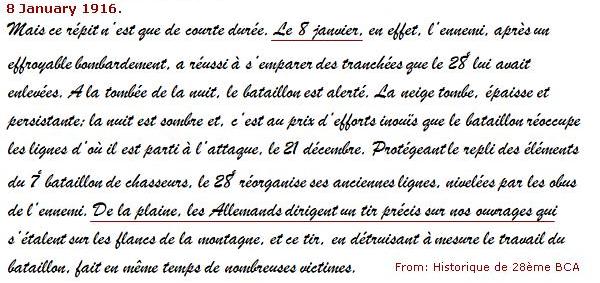
After the Minenwerfer bombardment I.R. 189 attacked the Hirzstein. The attack of units of the “Flammenwerfer-Abteilung Reddemann” and “Sturmabteilung Rohr” in the centre concentrated at the summit of the Hirzstein.
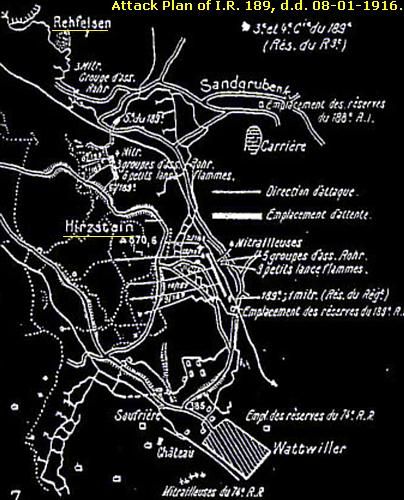
In spite of counter attacks by the 7e B.C.A., supported by the 28e B.C.A., these German units conquered within some hours all the former lines of 21 December of the 27e and 28e B.C.A. on the Hirzstein!
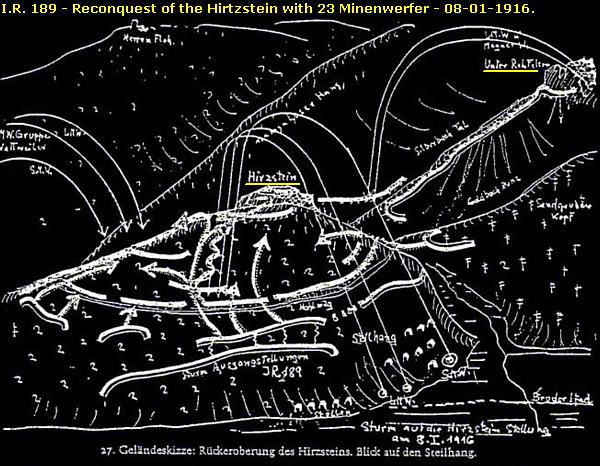
On 9 January the Germans controlled the height. The Germans made 1,108 Chasseurs Prisoners of War and captured 19 machine-guns. They would keep the Hirzstein in possession until the end of the war.
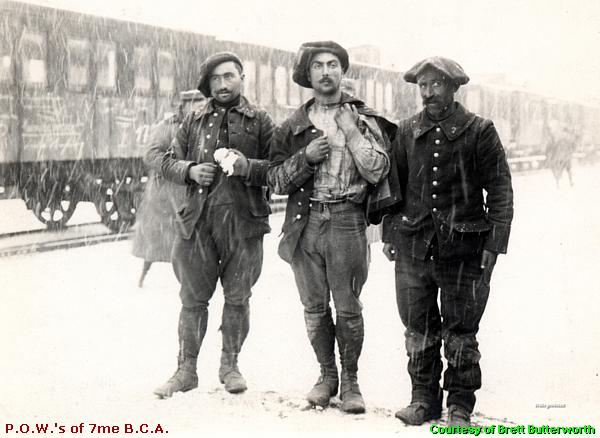
This German victory was of course big news in Germany.
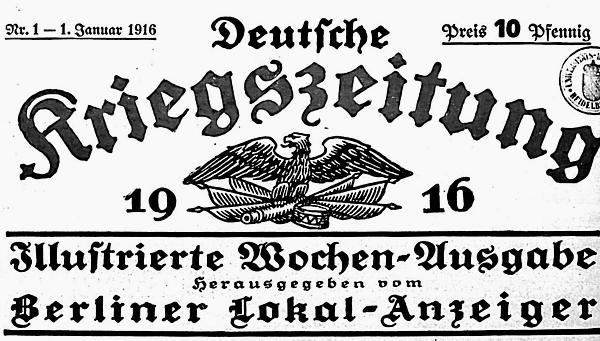
Two quotes of the weekly propaganda magazine, "Der Deutsche Kriegszeitung" of resp. 1 January 1916 and 9 January 1916:
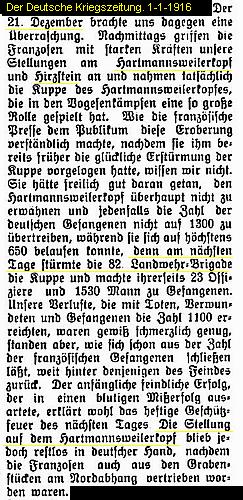
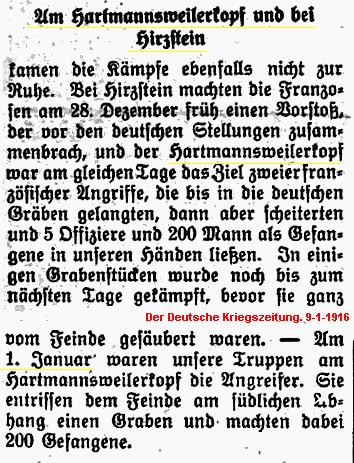
The news of this great German victory at the Hirzstein and of this French defeat even reached the press in the United States! The New York Times of 10 January 1916:
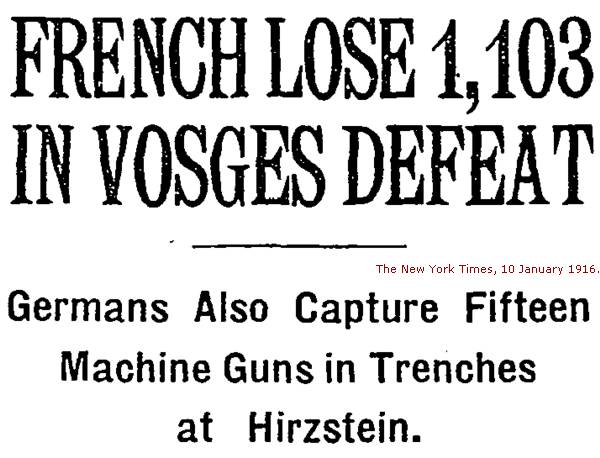

We are standing in front of a bunker, ...

... which was constructed after the battle ...
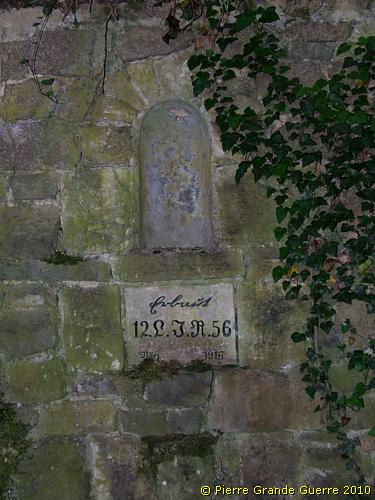
... by members of L.I.R. 56 in March 1916.
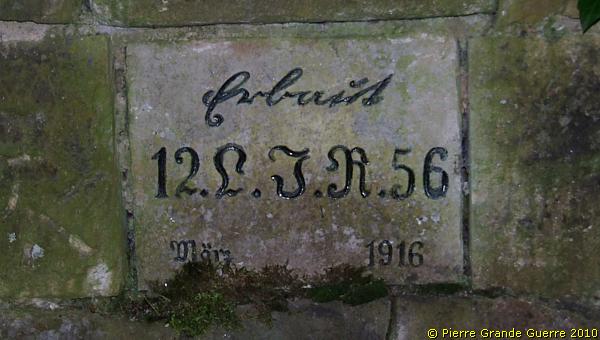
The Landwehr Infanterie Regiment 56
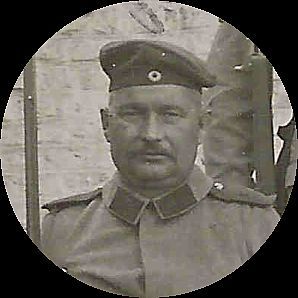
Krefeld is a city in the former Prussian state of Rheinland.
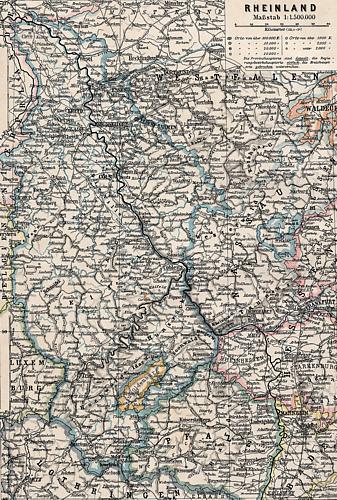
During the war it formed one of the seven contributing districts of men of the Landwehr Infanterie Regiment 56. Remind Krefeld for later on this page!
Together with Westphalia Rheinland forms nowadays the German Bundesland, Nordrhein-Westfalen.
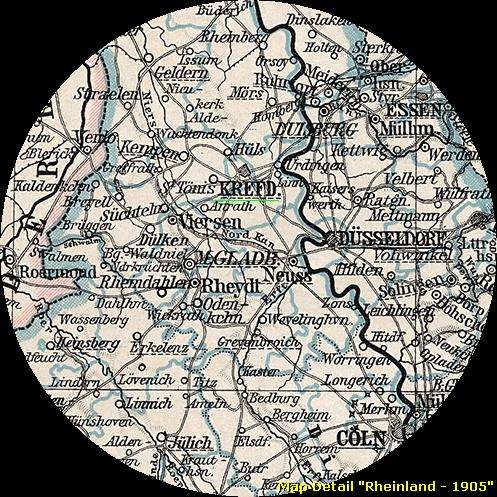
Landwehr Infanterie Regiment 56 was set up in September 1914 in Beverloo, a village in Belgium, from active servicable, young Landsturm men of the VIIth Armee Korps. The Ist battalion was formed from the Landsturm Inf. Btn. Duesseldorf (VII. 48 ) and Landsturm Inf. Btn. Mülheim Ruhr (VII. 59). The IInd battalion was formed from the Landsturm Inf. Btn. Detmold/Krefeld (VII. 96). The IIIrd battalion was formed from the Landsturm Inf. Btn. Dortmund (VII. 47) and Landsturm Inf. Btn. Gelsenkirchen (VII. 51). In 1915 the Landwehr Infanterie Regiment 56 was assigned to the 12. Landwehr Division , part of Armee Abteilung Gaede, for service in the Vosges until 1917.
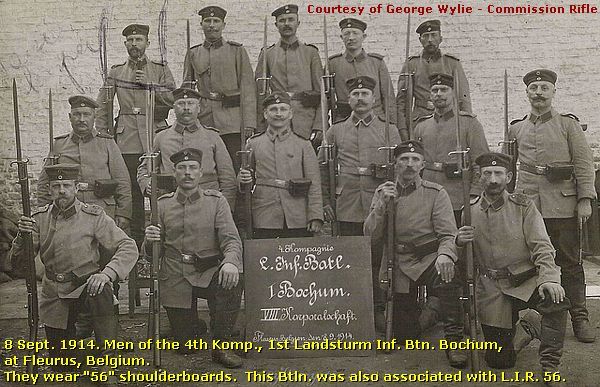

So, this bunker has been constructed by men of L.I.R. 56, a component of the 12. Landwehr Division.

As more often along the front; the bunker is used as dump.
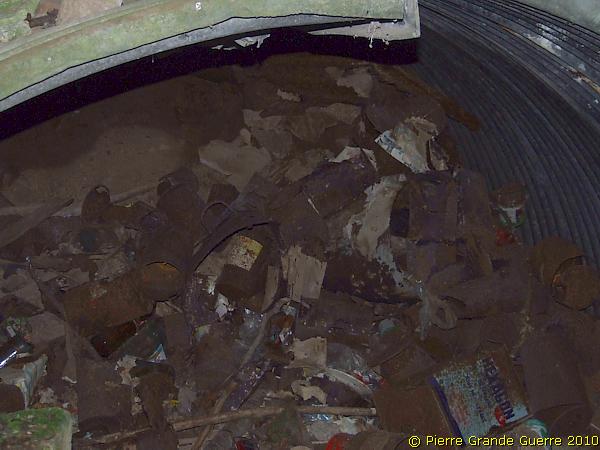
But amongst the modern garbage I still detect a relic: this china electricity cap is still intact.
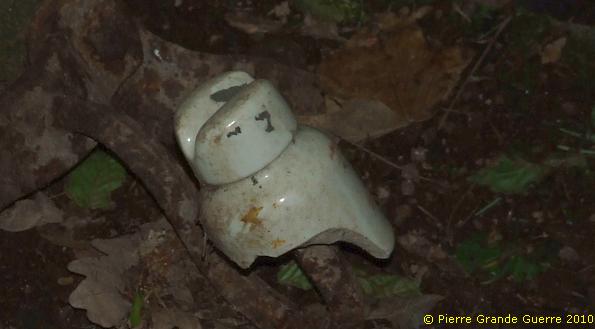

Some 25 m. eastward I find two identical bunkers next to each other.
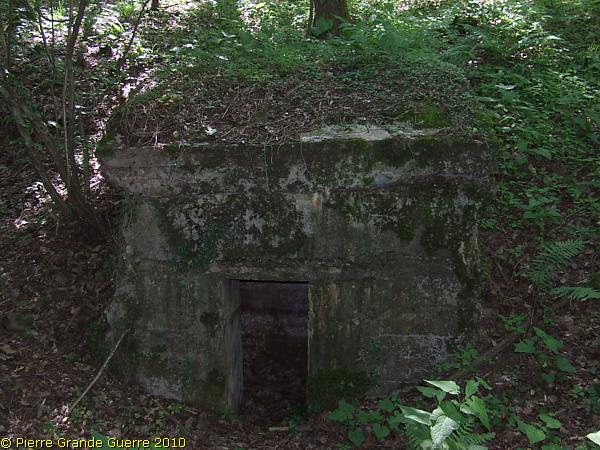
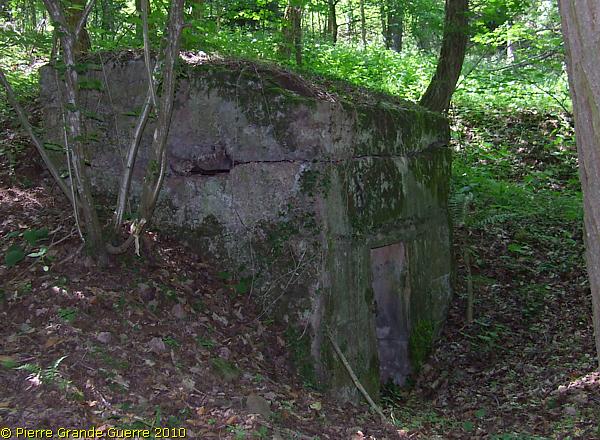
With a view at the Sandgrubenkopf, we follow ...

... a meandering track upward to find a third bunker.
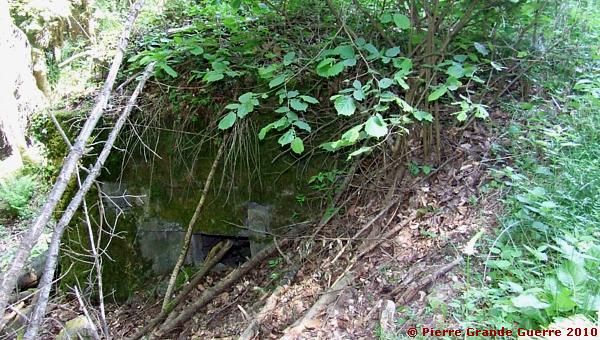
We return southward.
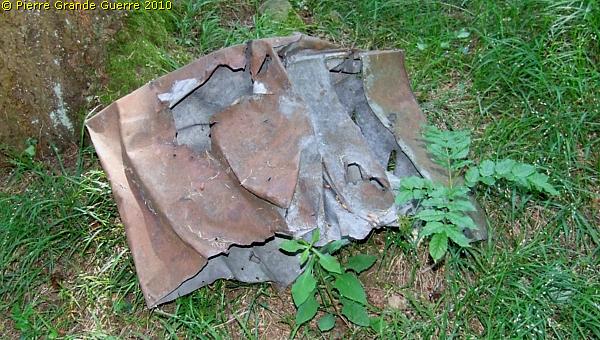
Relic of an elephant shelter.
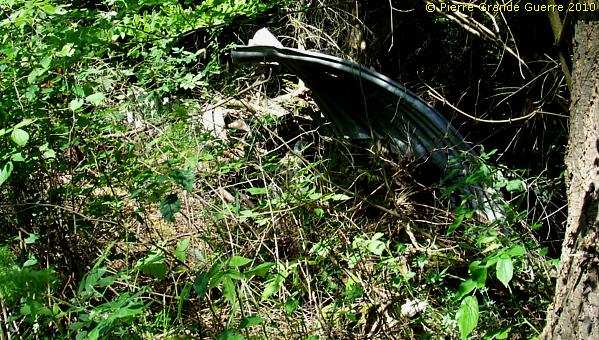
From the elephant shelter we continue to our last site of this walk. In the wood stands an almost forgotten wartime memorial.
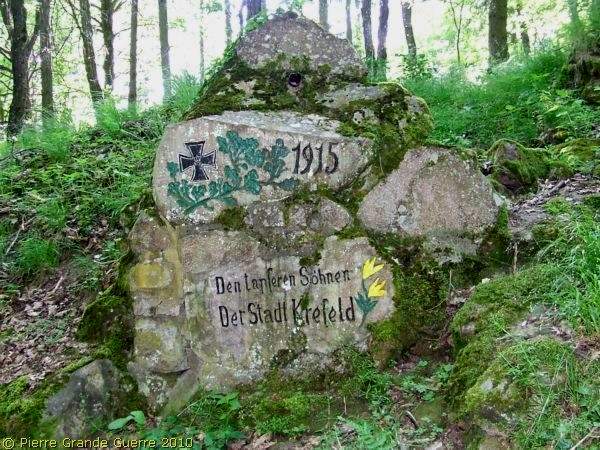
The inscription, "To the brave sons of the city of Krefeld", refers to fallen soldiers of the 2nd Btn. of L.I.R. 56.
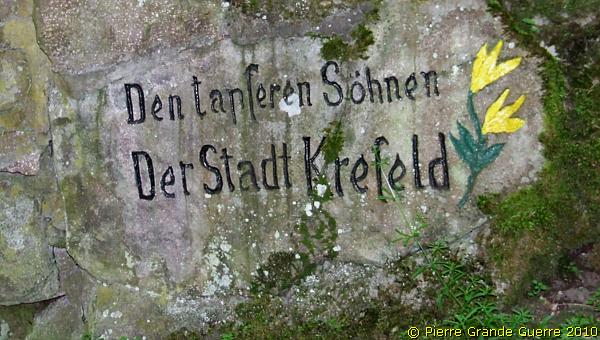
There must be many more sites to explore at the Hirzstein, but unfortunately, as more often happens, we ran out of time.

We return to the parking at the foot of the Hirzstein Rock.

Continue to the " Moosch Nécropole Nationale "










